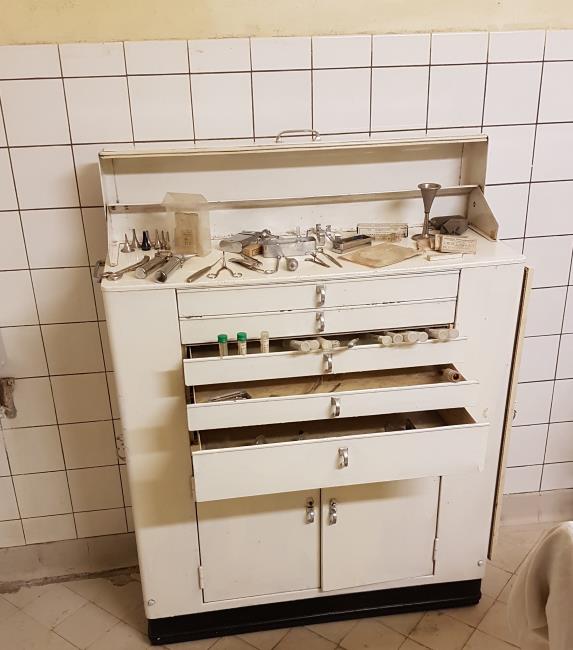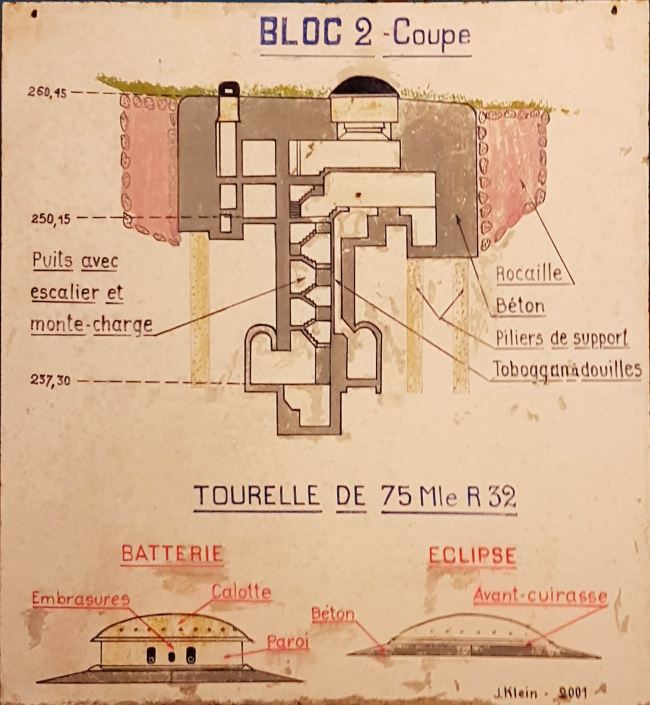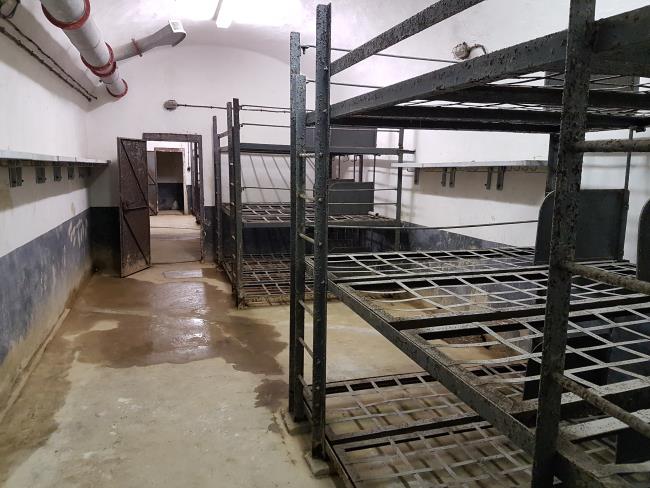 The teams had to eat standing up - there was no dining room. The officers had it better- but they did not have luxury either. It is hardly imaginable under which conditions the soldiers had to live at that time. They always did three months of service in the fortress. A long time without seeing daylight - perhaps comparable to the service in a submarine. Next were the sleeping quarters - these were heated by warm air to 64° Fahrenheit. The beds had steel frames on which a leather mattress filled with sea grass was placed. Slept was in eight hour shifts - always three people shared a bed. It must have been incredibly tight there, no trace of privacy. We further went through the bedroom of the sub-officers; they slept two to a bunk and had only a little more space than the teams. The officers' rooms were small, very simply furnished, but had at least a real bed. Then we came to the clinic. A few beds for the sick, a treatment room and then the operating room, which is still really well furnished. From there it goes to the dental office. At the sight of the treatment chair and the "torture instruments" you can be rigid with anxiety ......
The teams had to eat standing up - there was no dining room. The officers had it better- but they did not have luxury either. It is hardly imaginable under which conditions the soldiers had to live at that time. They always did three months of service in the fortress. A long time without seeing daylight - perhaps comparable to the service in a submarine. Next were the sleeping quarters - these were heated by warm air to 64° Fahrenheit. The beds had steel frames on which a leather mattress filled with sea grass was placed. Slept was in eight hour shifts - always three people shared a bed. It must have been incredibly tight there, no trace of privacy. We further went through the bedroom of the sub-officers; they slept two to a bunk and had only a little more space than the teams. The officers' rooms were small, very simply furnished, but had at least a real bed. Then we came to the clinic. A few beds for the sick, a treatment room and then the operating room, which is still really well furnished. From there it goes to the dental office. At the sight of the treatment chair and the "torture instruments" you can be rigid with anxiety ......
 We further went several hundred yards through the gloomy, oppressive tunnel system of the plant. We reached the battlefield of the fortress. Through the communication rooms, the commandant's office and the map room, we headed to the No. 2 combat block, which is accessible to visitors. The fortress originally had a total of six combat blocks.
We further went several hundred yards through the gloomy, oppressive tunnel system of the plant. We reached the battlefield of the fortress. Through the communication rooms, the commandant's office and the map room, we headed to the No. 2 combat block, which is accessible to visitors. The fortress originally had a total of six combat blocks.
The fortress was never conquered, but surrendered to the German occupiers on July 1, 1940, after the capitulation of France. The German occupiers made attempts in the combat block one with various explosives and destroyed it. Because the "press" was present, we were allowed to see the beginning of the spilled canal. Normally, it is not accessible to visitors.
 The ammunition camp was located on the lowest floor of the combat block. The rusted ammunition cabinets are silent, contemporary witnesses. The large ammunition boxes were transported through a rail system attached to the ceiling to the elevators. For us there was no elevator, we had to climb 104 steps in the combat block to the protected towers and guns. Over a huge lever system, the guarded towers were extended electrically – but, in some cases, also manually. Normally only a large metal dome was visible from the outside. If it was driven up, the double cannons could fire the surrounding area with a cadence of 60 rounds per minute and a range of six miles, in the 360° circle. Outside the fortress there were observers' bunkers, each with about 10 men, who were instructing the cannons through telephones. Our guide asked a visitor to the crank and after a few moments the guard tower had exited. A TV monitor on the wall shows the camera image which is directed at the dome. The retraction of the dome could also be seen very well. The gun was almost invulnerable while retracted. Then we went down many stairs again.
The ammunition camp was located on the lowest floor of the combat block. The rusted ammunition cabinets are silent, contemporary witnesses. The large ammunition boxes were transported through a rail system attached to the ceiling to the elevators. For us there was no elevator, we had to climb 104 steps in the combat block to the protected towers and guns. Over a huge lever system, the guarded towers were extended electrically – but, in some cases, also manually. Normally only a large metal dome was visible from the outside. If it was driven up, the double cannons could fire the surrounding area with a cadence of 60 rounds per minute and a range of six miles, in the 360° circle. Outside the fortress there were observers' bunkers, each with about 10 men, who were instructing the cannons through telephones. Our guide asked a visitor to the crank and after a few moments the guard tower had exited. A TV monitor on the wall shows the camera image which is directed at the dome. The retraction of the dome could also be seen very well. The gun was almost invulnerable while retracted. Then we went down many stairs again.

 After a few minutes through the galleries we reached the top of the 120 yards long oblique plane. It goes 75 feet down - on the right side 205 narrow steps which lead down to the level of the ammunition entrance. On the left are rails on which the ammunition carts were pulled up on steel ropes. On the lower level, we were able to see the power supply hall. In a room next to it, there are two ship motors that drove the emergency power units. Shortly before the exit stood the small museum. We were able to look at grenades of different caliber, some original pieces from the Second World War, pictures and old posters. After two hours, this extremely interesting tour was over. Unfortunately, it is only offered in German and French. For visitors with walking difficulties the visit of the fortress is not suitable due to the many stairs. Dogs are not allowed to my knowledge. I hope you enjoy this trip into the past.
After a few minutes through the galleries we reached the top of the 120 yards long oblique plane. It goes 75 feet down - on the right side 205 narrow steps which lead down to the level of the ammunition entrance. On the left are rails on which the ammunition carts were pulled up on steel ropes. On the lower level, we were able to see the power supply hall. In a room next to it, there are two ship motors that drove the emergency power units. Shortly before the exit stood the small museum. We were able to look at grenades of different caliber, some original pieces from the Second World War, pictures and old posters. After two hours, this extremely interesting tour was over. Unfortunately, it is only offered in German and French. For visitors with walking difficulties the visit of the fortress is not suitable due to the many stairs. Dogs are not allowed to my knowledge. I hope you enjoy this trip into the past.
- Details
- Written by Uwe Warnack
- Parent Category: Magazine
- Category: Sightseeing
- Hits: 6176

Comments powered by CComment